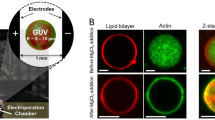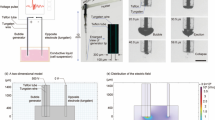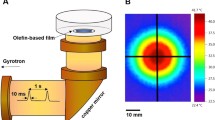Abstract
The role of actin fibers in cellular responses to external electric pulses is not clear yet. In this study, we utilized the blocker of actin polymerization, cytochalasin D (cytoD), and investigated its effects on the electropore generation. Eight 100 μs electric pulses of sub-kilovolt per centimeter voltage with 100 ms intervals were applied to adhered cells in vitro, and the membrane permeability was quantified using membrane-impermeable propidium iodide (PI) dye. With cytoD application, the transfer of PI dye decreased significantly in all the applied voltages. At the same time, the roughness of cells increased, the membrane stiffness decreased, and the transmembrane resting potential decreased. Our result supports that actin fibers have clear effects on electroporation through modulating membrane properties including transmembrane resting potential.








Similar content being viewed by others
References
Yarmush, M. L., Golberg, A., Serša, G., Kotnik, T., & Miklavčič, D. (2014). Electroporation-based technologies for medicine: principles, applications, and challenges. Annual Review of Biomedical Engineering, 16, 30295–30320.
Spencer, S. C. (1993). Electroporation technique of DNA transfection. Applied Biochemistry and Biotechnology, 42(1), 75–82.
Probst, U., Fuhrmann, I., Beyer, L., & Wiggermann, P. (2018). Electrochemotherapy as a new modality in interventional oncology: a review. Technology in Cancer Research & Treatment, 17, 1533033818785329.
Yang, W., Wu, Y. H., Yin, D., Koeffler, H. P., Sawcer, D. E., Vernier, P. T., & Gundersen, M. A. (2011). Differential sensitivities of malignant and normal skin cells to nanosecond pulsed electric fields. Technology in Cancer Research & Treatment, 10(3), 281–286.
Frandsen, S. K., Krüger, M. B., Mangalanathan, U. M., Tramm, T., Mahmood, F., Novak, I., & Gehl, J. (2017). Normal and malignant cells exhibit differential responses to calcium electroporation. Cancer Research, 77(16), 4389–4401.
Frandsen, S. K., Gissel, H., Hojman, P., Eriksena, J., & Gehl, J. (2014). Calcium electroporation in three cell lines: a comparison of bleomycin and calcium, calcium compounds, and pulsing conditions. Biochimica et Biophysica Acta, 1840(3), 1204–1208.
Potter, H. (2003). Transfection by electroporation. Current Protocols in Molecular Biology chapter 9, unit 93.
Kim, H. B., Lee, S., Shen, Y., Ryu, P.-D., Lee, Y., Chung, J. H., Sung, C. K., & Baik, K. Y. (2019). Physicochemical factors that affect electroporation of lung cancer and normal cell lines. Biochemical and Biophysical Research Communications, 517, 703e708.
Shagoshtasbi, H., Deng, P., & Lee, Y. K. (2015). A nonlinear size-dependent equivalent circuit model for single-cell electroporation on microfluidic chips. Journal of Laboratory Automation, 20(4), 481–490.
Agarwal, A., Zudans, I., Weber, E. A., Olofsson, J., Orwar, O., & Weber, S. G. (2007). Effect of cell size and shape on single-cell electroporation. Analytical Chemistry, 79(10), 3589–3596.
Aiken, E. J., Kilberg, B. G., Yu, S., Hagness, S. C., & Booske, J. H. (2018). Ionomycin-induced changes in membrane potential alter electroporation outcomes in HL-60 cells. Biophysical Journal, 114(12), 2875–2886.
Kennedy, S. M., Aiken, E. J., Beres, K. A., Hahn, A. R., Kamin, S. J., Hagness, S. C., Booske, J. H., & Murphy, W. L. (2014). Cationic peptide exposure enhances pulsed-electric-field-mediated membrane disruption. PLoS One, 9(3), e92528.
Mahmoud, A. A., Zeina, A. N., Farah, M., & Tahir, A. R. (2018). Electrical characterization of normal and cancer cells. IEEE access, 6, 25979–25986.
Kanduser, M., Sentjurc, M., & Miklavcic, D. (2006). Cell membrane fluidity related to electroporation and resealing. European Biophysics Journal, 35(3), 196–204.
van Uitert, I., Le Gac, S., & van den Berg, A. (2010). The influence of different membrane components on the electrical stability of bilayer lipid membranes. Biochimica et Biophysica Acta, 1798(1), 21–31.
Cemazar, M., Jarm, T., Miklavcic, D., Lebar, A. M., Ihan, A., Kopitar, N. A., & Sersa, G. (1998). Effect of electric-field intensity on electropermeabilization and electrosensitivity of various tumor-cell lines in vitro. Electro- and Magnetobiology, 17(2), 263–272.
Gianulis, E. C., Labib, C., Saulis, G., Novickij, V., Pakhomova, O. N., & Pakhomov, A. G. (2017). Selective susceptibility to nanosecond pulsed electric field (nsPEF) across different human cell types. Cellular and Molecular Life Sciences, 74(9), 1741–1754.
Goldmann, W. H. (2008). Actin: a molecular wire, an electrical cable. Cell Biology International, 32(7), 869–870.
Kanthou, C., Kranjc, S., Sersa, G., Tozer, G., Zupanic, A., & Cemazar, M. (2006). The endothelial cytoskeleton as a target of electroporation-based therapies. Molecular Cancer Therapeutics, 5(12), 3145–3152.
Pakhomov, A. G., Xiao, S., Pakhomova, O. N., Semenov, I., Kuipers, M. A., & Ibey, B. L. (2014). Disassembly of actin structures by nanosecond pulsed electric field is a downstream effect of cell swelling. Bioelectrochemistry, 100, 88–95.
Deyou, X., Tang, L., Zeng, C., Wang, J., Luo, X., Yao, C., & Sun, C. (2011). Effect of actin cytoskeleton disruption on electric pulse induced apoptosis and electroporation in tumour cells. Cell Biology International, 35(2), 99–104.
Thompson, G. L., Roth, C. Tolstykh, G. Kuipers, M. Ibey, B. L. (2013). Role of cytoskeleton and elastic moduli in cellular response to nanosecond pulsed electric fields, Proc. SPIE 8585, Terahertz and Ultrashort Electromagnetic Pulses for Biomedical Applications, 85850.
Stacey, M., Fox, P., Buescher, S., & Kolb, J. (2011). Nanosecond pulsed electric field induced cytoskeleton, nuclear membrane and telomere damage adversely impact cell survival. Bioelectrochemistry, 82(2), 131–134.
Blangero, C., Rols, M. P., & Teissie, J. (1989). Cytoskeletal reorganization during electric-field-induced fusion of Chinese hamster ovary cells grown in monolayers. Biochimica et Biophysica Acta, 981(2), 295–302.
Teissie, J., & Rols, M. P. (1994). Manipulation of cell cytoskeleton affects the lifetime of cell membrane electropermeabilization. Annals of the New York Academy of Sciences, 720, 98–110.
Perrier, D. L., Vahid, A., Kathavi, V., Stam, L., Rems, L., Mulla, Y., Muralidharan, A., Koenderink, G. H., Kreutzer, M. T., & Boukany, P. E. (2019). Response of an actin network in vesicles under electric pulses. Scientific Reports, 9(1), 8151.
Choi, Y. S., Kim, H. B., Chung, J., Kim, H. S., Yi, J. H., & Park, J. K. (2010). Preclinical analysis of irreversible electroporation on rat liver tissues using a microfabricated electroporator. Tissue Engineering Part C Methods, 16(6), 1245–1253.
Domke, J., & Radmacher, M. (1989). Measuring the elastic properties of thin polymer films with the AFM. Langmuir, 14(12), 3320–3325.
Hernández, J. A., & Chifflet, S. (2000). Electrogenic properties of the sodium pump in a dynamic model of membrane transport. The Journal of Membrane Biology, 176(1), 41–52.
Strickholm, A. (1981). Ionic permeability of K, Na, and Cl in potassium-depolarized nerve. Biophys J., 35(3).
Schoenbach, K. H., Stephen, J., Ravindra, P., Juergen, F., Richard, N., Christopher, O., Andrei, P., Miichael, S., James, S., Jody, A., Shu, X., Stephen, J., Peter, F., & Stehpen, B. (2007). Bioelectric effects of intense nanosecond pulses. IEEE Transactions on Dielectrics and Electrical Insulation, 14(5), 1088–1109.
Xiao, D., Tang, L., Zeng, C., Wang, J., Luo, X., Yao, C., & Sun, C. (2011). Effect of actin cytoskeleton disruption on electric pulse-induced apoptosis and electroporation in tumour cells. Cell Biology International, 35(2), 99–104.
Stevenson, B. R., & Begg, D. A. (1994). Concentration-dependent effects of cytochalasin d on tight junctions and actin filaments in MDCK epithelial cells. Journal of Cell Science, 107, 367–375.
Kanzo, S. (2015). Improving physical methods of cell permeabilization by reducing plasma membrane stiffness in HeLa cells. Thesis, McGill University.
Frey, W., White, J. A., Price, R. O., Blackmore, P. F., Joshi, R. P., Nuccitelli, R., Beebe, S. J., Schoenbach, K. H., & Kolb, J. F. (2006). Plasma membrane voltage changes during nanosecond pulsed electric field exposure. Biophysical Journal, 90(10), 3608–3615.
Kanduser, M., & Miklavcic, D. (2009). Electroporation in biological cell and tissue: an overview. Food Engineering Series, 1–37.
Marszalek, P., Liu, D., & Tsong, T. (1990). Schwan equation and transmembrane potential induced by altering electric field. Biophysical Journal, 58(4), 1053–1058.
Grosse, C., & Schwan, H. (1992). Cellular membrane potentials induced by altering fields. Biophysical Journal, 63(6), 1632–1642.
Teissié, J., & Rols, M. (1993). An experimental evaluation of the critical potential difference inducing cell membrane electropermeabilization. Biophysical Journal, 65(1), 409–413.
Veech, R., Kashiwaya, Y., & King, M. (1995). The resting membrane potential of cells are measures of electrical work, not of ionic currents. Integrative Physiological and Behavioral Science, 30(4), 283–307.
Barrau, C., Teissie, J., & Gabriel, B. (2004). Osmotically induced membrane fusion facilitates the triggering of living cell electroporation. Bioelectrochemistry, 63(1–2), 327–332.
Djuzenova, C. S., Zimmermann, U., Frank, H., Sukhorukov, V. L., Richter, E., & Fuhr, G. (1996). Effect of medium conductivity and composition on the uptake of propidium iodide into electropermeabilized myeloma cells. Biochimica et Biophysica Acta, 1284(2), 143–152.
Saunders, J. A., Smith, C. R., & Kaper, J. M. (1989). Effects of electroporation pulse wave on the incorporation of viral RNA into tobacco protoplasts. Biotechniques, 7(10), 1124–1131.
Chiara, C., Fels, J., Liashkovich, I., Kliche, K., Jeggle, P., Kusche-Vihrog, K., & Oberleithner, H. (2011). Membrane potential depolarization decreases the stiffness of vascular endothelial cells. Journal of Cell Science, 124(Pt 11), 1936–1942.
Oberleithner, H., Callies, C., Kusche-Vihrog, K., Schillers, H., Shahin, V., Riethmüller, C., Macgregor, G. A., & de Wardener, H. E. (2009). Potassium softens vascular endothelium and increases nitric oxide release. Proceedings of the National Academy of Sciences, 106(8), 2829–2834.
Funding
This work was supported by the Ministry of SMEs and Startups (grant numbers S2459501) (Korea) and supported by Kwangwoon University 2018.
Author information
Authors and Affiliations
Corresponding authors
Ethics declarations
Conflict of Interest
The authors declare that they have no competing interests.
Additional information
Publisher’s Note
Springer Nature remains neutral with regard to jurisdictional claims in published maps and institutional affiliations.
Rights and permissions
About this article
Cite this article
Kim, H.B., Lee, S., Chung, J.H. et al. Effects of Actin Cytoskeleton Disruption on Electroporation In Vitro. Appl Biochem Biotechnol 191, 1545–1561 (2020). https://doi.org/10.1007/s12010-020-03271-4
Received:
Accepted:
Published:
Issue Date:
DOI: https://doi.org/10.1007/s12010-020-03271-4




